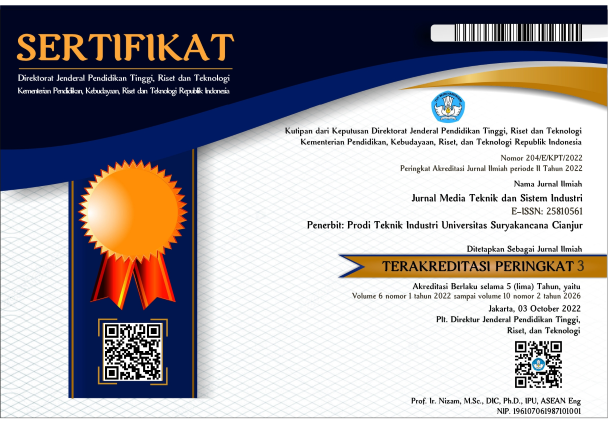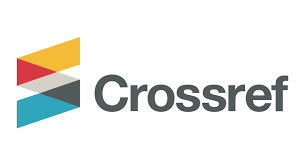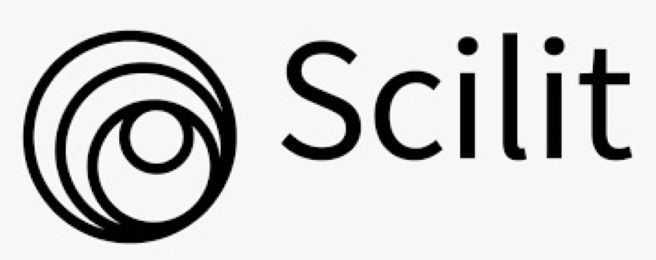Implementasi Metode Six Sigma Untuk Mereduksi Cacat Pada Produksi Sendok Premium (Studi Kasus PT. ABC)
Abstract
PT ABC is a company in the manufacturing industry that produces premium spoons. The raw material used is 304 stainless steel. The high volume of defective production impacts reducing the level of customer satisfaction so that it indirectly causes losses to the company. The maximum defect rate determined and allowed by the company is 4.25% of total production. This study aims to determine critical defects and provide alternative improvements to reduce the level of product defects and increase the sigma level in making premium spoons. In this study, the Six Sigma method is used to determine the sigma level to be used as a reference in making corrective actions; the existing condition shows that the sigma level is 4.29, indicating that corrective steps need to be taken. The results showed that by analyzing Pareto diagrams, three critical defects occurred in spoon products: warping 98 pieces, freckles 102 pieces, and Discoloration 99 pieces. The root Cause Analysis method is used to identify factors that cause defects in spoons. The FMEA method is used to provide alternative improvements by reducing the potential for failure by considering the RPN value, where the RPN value of warping defects is 60, the RPN value of freckles defects is 60, and the highest RPN value obtained by Discoloration defects is 64. At the improvement stage, alternative improvements are given; from the proposed improvements, a decrease in the number of defects is obtained, which for warping defects is 15.5%, freckles are 16%, and Discoloration is 12.8% with a total decrease in the number of defects is 44.3%. From the results of the improvements that have been implemented, the DPMO value is 7,800 with a sigma level of 4.74.
Â
PT ABC adalah sebuah perusahaan dibidang industri manufaktur yang memproduksi sendok premium. Bahan baku yang digunakan yaitu stainless steel 304. Tingginya volume produksi yang cacat berdampak pada menurunnya tingkat kepuasan konsumen sehingga secara tidak langsung menimbulkan kerugian bagi perusahaan. Tingkat kecacatan maksimum yang telah ditentukan dan diizinkan perusahaan adalah 4,25% dari total produksi. Penelitian ini bertujuan untuk mengetahui cacat kritis dan memberikan alternatif perbaikan yang dilakukan sebagai upaya untuk menurunkan tingkat cacat produk serta meningkatkan level sigma pada proses pembuatan sendok premium. Pada penelitian ini metode Six Sigma digunakan untuk mengetahui level sigma sehingga dapat dijadikan sebagai acuan dalam membuat tindakan perbaikan, kondisi eksisting menunjukkan bahwa level sigma bernilai 4,29, kondisi ini menunjukkan perlu dilakukan langkah perbaikan. Hasil penelitian menunjukkan bahwa dengan melakukan analisis diagram pareto terdapat 3 jenis cacat kritis yang terjadi pada produk sendok: warping 98 buah, freckles 102 buah, dan Discoloration 99 buah. Metode Root Cause Analysis digunakan untuk mengidentifikasi faktor yang menjadi penyebab terjadinya cacat pada sendok. Metode FMEA digunakan untuk memberikan alternatif perbaikan dengan mereduksi potensi terjadinya kegagalan dengan mempertimbangkan nilai RPN, di mana nilai RPN cacat warping adalah sebesar 60, nilai RPN cacat freckles adalah sebesar 60 dan nilai RPN tertinggi diperoleh oleh cacat Discoloration adalah sebesar 64. Pada tahapan improve diberikan alternatif perbaikan, dari usulan perbaikan diperoleh tingkat penurunan jumlah cacat yang di mana untuk cacat warping sebesar 15,5%, freckles adalah sebesar 16%, dan Discoloration sebesar 12,8% dengan total nilai penurunan jumlah cacat adalah 44,3%. Dari hasil perbaikan yang sudah diterapkan, diperoleh nilai DPMO sebesar 7.800 dengan level sigma bernilai sebesar 4.74.
Keywords
References
S. Srivatsa Srinivas and V. Raja Sreedharan, “Failure analysis of automobile spares in a manufacturing supply chain distribution centre using Six Sigma DMAIC framework,†2018.
A. Fakhrus Sanny and A. Hoyyi, “implementasi metode lean Six Sigma sebagai upaya meminimalisasi cacat produk kemasan cup air mineral 240 ml (studi kasus perusahaan air minum),†JURNAL GAUSSIAN, vol. 4, no. 2, pp. 227–236, 2015.
M. Smętkowska and B. Mrugalska, “Using Six Sigma DMAIC to Improve the Quality of the Production Process: A Case Study,†Procedia Soc Behav Sci, vol. 238, pp. 590–596, 2018.
Afnina and Y. Hastuti, “Pengaruh Kualitas Produk terhadap Kepuasan Pelanggan,†Samudra Ekonomi dan Bisnis, vol. 9, no. 1, pp. 21–30, 2018.
D. G. Tambunan, B. Sumartono, and D. H. Moektiwibowo, “Analisis Pengendalian Kualitas Dengan Metode Six Sigma Dalam Upaya Mengurangi Kecacatan Pada Proses Produksi Koper Di Pt Srg,†Journal Teknik Industri, pp. 58–77, 2020.
I. Vanany, K. Hua Tan, N. Siswanto, N. I. Arvitrida, and F. M. Pahlawan, “Halal Six Sigma framework for defects reduction,†Journal of Islamic Marketing, vol. 12, no. 4, pp. 776–793, 2020.
A. C.R and J. J. Thakkar, “Application of Six Sigma DMAIC methodology to reduce the defects in a telecommunication cabinet door manufacturing process: A case study,†International Journal of Quality and Reliability Management, vol. 36, no. 9, pp. 1540–1555, Sep. 2019.
T. Ahmed et al., “Implementation of the Six Sigma Methodology for Reducing Fabric Defects on the Knitting Production Floor: A Sustainable Approach for Knitting Industry,†Industry. Textile & Leather Review, vol. 5, pp. 223–239, 2022.
V. S. Patyal, S. Modgil, and M. Koilakuntla, “Application of Six Sigma methodology in an Indian chemical company,†International Journal of Productivity and Performance Management, vol. 70, no. 2, pp. 350–375, Jan. 2021.
P. Pangestu and F. Fahma, “Implementasi Six Sigma dalam Peningkatan Kualitas Proses Produksi LED TV di PT Sharp Electronics Indonesia,†PERFORMA Media Ilmiah Teknik Industri, vol. 17, no. 2, Jul. 2019.
C. Setia Bakti, H. Kartika, and J. Raya Meruya Selatan, “ANALISA PENGENDALIAN KUALITAS PRODUK ICE CREAM DENGAN METODE SIX SIGMA,†Journal of Industrial Engineering & Management Research, vol. 1, no. 1, pp. 63–69, 2020.
H. S. Sodhi, D. Singh, and B. J. Singh, “A conceptual examination of Lean, Six Sigma and Lean Six Sigma models for managing waste in manufacturing SMEs,†World Journal of Science, Technology and Sustainable Development, vol. 17, no. 1, pp. 20–32, Jan. 2020.
Y. H. Kwak and F. T. Anbari, “Benefits, obstacles, and future of Six Sigma approach,†Technovation, vol. 26, no. 5–6, pp. 708–715, May 2006.
B. Justin Bateh and J. Farah, “Reducing Call Center Wait Times Through Six Sigma,†The Journal of Business Inquiry, vol. 2, pp. 131–148, 2017.
A. Ishak, K. Siregar, Asfriyati, and H. Naibaho, “Quality Control with Six Sigma DMAIC and Grey Failure Mode Effect Anaysis (FMEA): A Review,†in IOP Conference Series: Materials Science and Engineering, Institute of Physics Publishing, Jul. 2019.
W. Truscott, “Six Sigma: Continual Improvement for Businesses,†in Butterworth Heinemann, Amsterdam: 2003, 2003, pp. 1–250.
Thomas. Pyzdek, The Six Sigma handbook: a complete guide for green belts, black belts, and managers at all levels. McGraw-Hill, 2003.
P. Sharma, S. C. Malik, A. Gupta, and P. C. Jha, “A DMAIC Six Sigma approach to quality improvement in the anodising stage of the amplifier production process,†International Journal of Quality and Reliability Management, vol. 35, no. 9, pp. 1868–1880, Oct. 2018.
A. Khaleil Akmal, R. Irawan, K. Hadi, H. Tri Irawan, I. Pamungkas, and Kasmawati, “Pengendalian Kualitas Produk Paving Block untuk Meminimalkan Cacat Menggunakan Six Sigma pada UD. Meurah Mulia,†Jurnal Optimasi, vol. 7, pp. 236–248, 2021.
V. S. Patyal and K. Maddulety, “Interrelationship between Total Quality Management and Six Sigma: A Review,†Global Business Review, vol. 16, no. 6, pp. 1025–1060, Dec. 2015.
S. Gupta, S. Modgil, and A. Gunasekaran, “Big data in lean Six Sigma: a review and further research directions,†International Journal of Production Research, vol. 58, no. 3. Taylor and Francis Ltd., pp. 947–969, Feb. 01, 2020.
J. Antony, “Six Sigma for service processes,†Business Process Management Journal, vol. 12, no. 2, pp. 234–248, 2006.
C. Lim, M. J. Kim, K. H. Kim, K. J. Kim, and P. Maglio, “Customer process management: A framework for using customer-related data to create customer value,†Journal of Service Management, vol. 30, no. 1, pp. 105–131, Feb. 2019.
M. Afiah and M. L. Singgih, “Reduksi Cacat pada Produk Kaca Lembaran Dengan Metode Six Sigma,†Jurnal Teknik ITS, vol. 6, no. 2, Sep. 2017.
R. Godina, B. G. R. Silva, and P. Espadinha-Cruz, “A DMAIC integrated fuzzy fmea model: A case study in the automotive industry,†Applied Sciences (Switzerland), vol. 11, no. 8, Apr. 2021.
S. V. Patil, K. Balakrishna Rao, and G. Nayak, “Quality improvement of recycled aggregate concrete using Six Sigma DMAIC methodology,†International Journal of Mathematical, Engineering and Management Sciences, vol. 5, no. 6, pp. 1409–1419, 2020.
L. Girmanová, M. Šolc, J. Kliment, A. Divoková, and V. Mikloš, “Application of Six Sigma Using DMAIC Methodology in the Process of Product Quality Control in Metallurgical Operation,†Acta Technologica Agriculturae, vol. 20, no. 4, pp. 104–109, Dec. 2017.
W. Perry and N. Mehltretter, “Applying Root Cause Analysis to Compressed Air: How to Solve Common Compressed Air System Problems with the 5-Whys*,†Energy Engineering: Journal of the Association of Energy Engineering, vol. 115, no. 4, pp. 56–62, Jul. 2018.
K. Dev, S. Gurukula, K. Vishwavidyalaya, S. Srivastava, and G. Kangri Vishwavidyalaya, “Failure Mode and Effect Analysis (FMEA) Implementation: A Literature Review Bottling of Biogas-A Renewable Approach View project,†Journal of Advance Research in Aeronautics and Space Science, vol. 5, no. 1 & 2, pp. 1–7, 2018.
C. Spreafico, D. Russo, and C. Rizzi, “A state-of-the-art review of FMEA/FMECA including patents,†Computer Science Review, vol. 25. Elsevier Ireland Ltd, pp. 19–28, Aug. 01, 2017.
DOI: https://doi.org/10.35194/jmtsi.v7i2.2728
Refbacks
- There are currently no refbacks.

This Journal is licensed under a Creative Commons Attribution-ShareAlike 4.0 International License.
Jurnal Media Teknik dan Sistem Industri ISSN: 2581-0561 (online); 2581-0529 (cetak).
Gedung Fakultas Teknik UNSUR Jl. Pasir Gede Raya, Cianjur, Jawa Barat 43216| Telp./Fax. (0263) 283578 |E-mail: jmtsi@unsur.ac.id
JMTSI (Jurnal Media Teknik dan Sistem Industri) INDEXED BY :


















